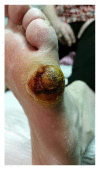Mistaken Diabetic Ulcers: A Case of Bilateral Foot Verrucous Carcinoma
- PMID: 29796321
- PMCID: PMC5896404
- DOI: 10.1155/2018/4192657
Mistaken Diabetic Ulcers: A Case of Bilateral Foot Verrucous Carcinoma
Erratum in
-
Corrigendum to "Mistaken Diabetic Ulcers: A Case of Bilateral Foot Verrucous Carcinoma".Case Rep Dermatol Med. 2018 Apr 15;2018:6405129. doi: 10.1155/2018/6405129. eCollection 2018. Case Rep Dermatol Med. 2018. PMID: 29849220 Free PMC article.
Abstract
Verrucous carcinoma (VC) is a rare, low-grade, and well-differentiated variant of squamous cell carcinoma. These tumors are slow-growing and exophytic and have a negligible incidence of metastasis. Treatment is complete surgical resection, ideally by Mohs micrographic surgery, to ensure adequate clear margins. Cutaneous VC predominantly occurs on the plantar surface of the foot and rarely occurs in multiple sites. This case study describes the fourth reported occurrence of bilateral VC of the feet in a woman with chronic diabetic foot ulcers. The case provides further support for persistent wounds contributing to the development of this lesion and describes their role in the characteristic delay in diagnosis of VC.
Figures



References
-
- Ackerman L. V. Verrucous carcinoma of the oral cavity. Surgery. 1948;23(4):670–678. - PubMed
Publication types
LinkOut - more resources
Full Text Sources
Other Literature Sources

